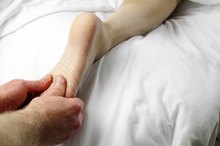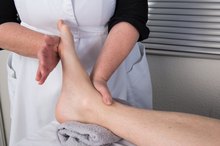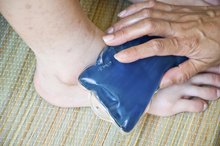What does fact checked mean?
At Healthfully, we strive to deliver objective content that is accurate and up-to-date. Our team periodically reviews articles in order to ensure content quality. The sources cited below consist of evidence from peer-reviewed journals, prominent medical organizations, academic associations, and government data.
- Burns & Trauma: Biomaterials and Tissue Engineering for Scar Management in Wound Care
- Burns & Trauma: Biomaterials and Tissue Engineering for Scar Management in Wound Care
The information contained on this site is for informational purposes only, and should not be used as a substitute for the advice of a professional health care provider. Please check with the appropriate physician regarding health questions and concerns. Although we strive to deliver accurate and up-to-date information, no guarantee to that effect is made.
6 Ways to Remove or Treat Scar Tissue on Your Foot With Rehab
Scar tissue can occur on the outside or inside of your foot, especially when your injury disrupts the skin. Scar tissue is also common after surgery. This scar tissue can inhibit your foot's movement and strength.
Whether you see a physical therapist or perform rehab at home, interventions help manage scar tissue as you heal and regain strength and flexibility. Your rehabilitation program will focus on your supporting muscles and tendons as your scar forms and prevention of further injury.
Read more: Healing Stages of Scars
Manage Your Swelling
Intermittently rest your foot regularly to avoid overexertion during daily activity. Many physical therapists provide ice or heat treatments to reduce swelling and speed healing to your scar tissue. This is done throughout your rehabilitation.
You may also be instructed to prop your foot at home and apply ice or heat to aid in the healing process. In between sessions, you might be instructed to keep your foot wrapped with an elastic bandage to help flatten your scar and reduce swelling.
- Intermittently rest your foot regularly to avoid overexertion during daily activity.
- You may also be instructed to prop your foot at home and apply ice or heat to aid in the healing process.
Perform Scar Massage
Physical Therapy Exercises for a Hyperextended Toe
Learn More
Massage your foot at the injury site for five to 10 minutes per day.
Move Your Foot
Stretch your ankle, foot and toes two to three times daily to increase flexibility. As scar tissue forms, your foot's natural movement is inhibited as your muscles become stiff. This is a normal part of the healing process. Stretching your foot muscles will warm the affected area and help prevent stiffening from occurring.
- Stretch your ankle, foot and toes two to three times daily to increase flexibility.
- Stretching your foot muscles will warm the affected area and help prevent stiffening from occurring.
Do Ankle Circles
How to Increase Flexibility in My Big Toes
Learn More
Rotate each joint in your foot daily to increase range of motion as part of a program for breaking down scar tissue in your foot. Range of motion is important to restoring full movement and healing potential to scar tissue.
By rolling your ankle or flexing your foot several times a day, you can increase natural movement and help increase blood circulation to scar tissue after surgery. Focus on the movements that stretch your scar. For example, if you have scar tissue on the top of your foot, spend more time pointing your toes down toward the ground.
Read more: How to Get Rid of Scars on Toes
- Rotate each joint in your foot daily to increase range of motion as part of a program for breaking down scar tissue in your foot.
- By rolling your ankle or flexing your foot several times a day, you can increase natural movement and help increase blood circulation to scar tissue after surgery.
Return to Function
Increase your exercise routines gradually. Returning to full activity can worsen scar tissue and cause further injury. Begin exercising a few minutes each day, gradually adding one to two minutes to your exercise time each time. This allows scar tissue to heal and muscle strength to return naturally.
- Increase your exercise routines gradually.
- Returning to full activity can worsen scar tissue and cause further injury.
Preventing Excess Scar Tissue
According to a 2017 study published by Burns & Trauma, natural materials such as:
- honey
- curcumin
- extract from pine bark
- relaxin
- crocodile oil have all been shown to decrease scar formation after injury
Related Articles
References
- Massage Today: The Importance of Scar Tissue Release Therapy
- Burns & Trauma: Biomaterials and Tissue Engineering for Scar Management in Wound Care
- Shin TM, Bordeaux JS. The role of massage in scar management: a literature review. Dermatol Surg. 2012;38(3):414-23. doi:10.1111/j.1524-4725.2011.02201.x
- Ault P, Plaza A, Paratz J. Scar massage for hypertrophic burns scarring-A systematic review. Burns. 2018;44(1):24-38. doi:10.1016/j.burns.2017.05.006
- Cheatham SW, Lee M, Cain M, Baker R. The efficacy of instrument assisted soft tissue mobilization: a systematic review. J Can Chiropr Assoc. 2016;60(3):200-211.
- Kohata K, Itoh S, Horiuchi N, Yoshioka T, Yamashita K. Influences of osteoarthritis and osteoporosis on the electrical properties of human bones as in vivo electrets produced due to Wolff's law. Biomed Mater Eng. 2017;28(1):65-74. doi:10.3233/BME-171657
- Cheatham, S. Et al. The Efficacy of Instrument Assisted Soft Tissue Mobilization: A Systematic Review. J Can. Chiro, Assoc. 2016 Sep; 60(3): 200-11.
- Kim J, Sung DJ, Lee J. Therapeutic effectiveness of instrument-assisted soft tissue mobilization for soft tissue injury: mechanisms and practical application.Journal of Exercise Rehabilitation. 2017;13(1):12-22. doi:10.12965/jer.1732824.412.
- Kisner, C., & Colby, L. A. Therapeutic exercise: Foundations and techniques. (3 ed.). Philadelphia: FA Davis.
- Shin TM, Bordeaux JS. The Role of Massage in Scar Management: A Literature Review.Dermatologic Surgery. 2012;38(3):414-423. doi:10.1111/j.1524-4725.2011.02201.x.
Writer Bio
Sharin Griffin has been a freelance writer since 2009, specializing in health-related articles. She has worked in the health-care industry as a certified nursing assistant and medical technician. Griffin's medical expertise encompasses bariatrics and geriatric care, with an emphasis on general medicine. She is completing an associate degree in health-care administration from Axia University.









